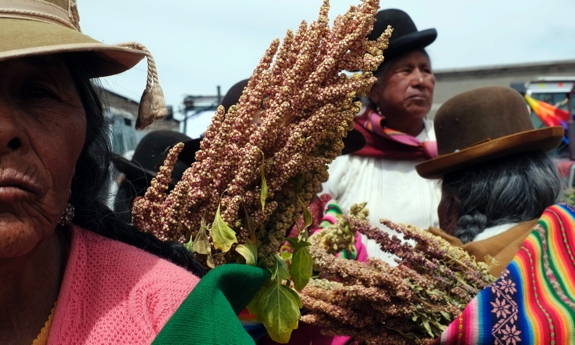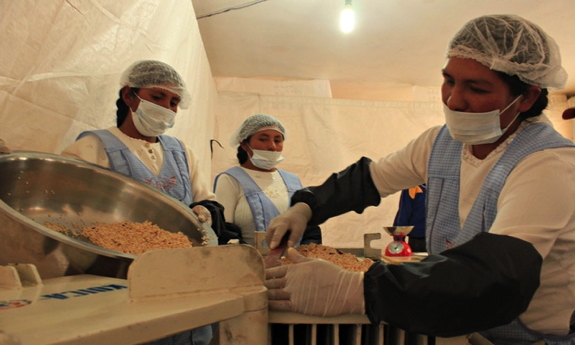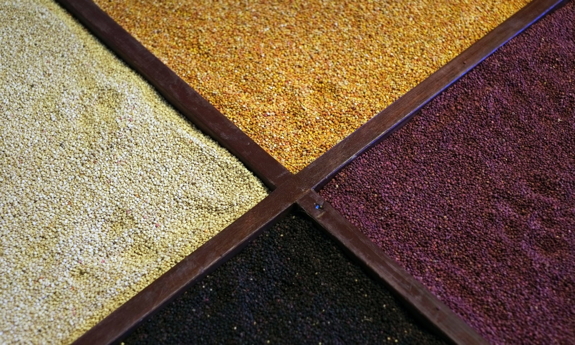
(above) Bolivian women carry Quinoa plants on their backs. Farmers are hoping to gain from the nutritional, ecological and economic benefits of this resource. Photograph: David Mercado/Reuters
Bolivian women bank on sweet success of quinoa bars
January 5, 2015 - Guardian
Women in a Bolivian cooperative hope to boost income by adding value to their quinoa crop through making chocolate-coated energy bars
Behind curtains of plastic sheeting in a small room off the main square of a highland town, four women are doing something novel, tasty and very nearly healthy with quinoa, Bolivia's ancient grano de oro (golden grain).
They mix the tiny spheres of the Andean staple with coconut, peanuts and sugar syrup, before pressing and cooking them. Some are left as they are when they emerge from the oven; the lucky ones are half-dipped in Bolivian chocolate.
After being packaged and sealed, the 800 energy bars they produce each day await distribution. A quarter will end up at an exclusive gym in La Paz – where they sell for five bolivianos (about $0.70) each – others will provide breakfast for local children, while the rest will be sold at a discount to local shops and families, or swapped for the milk, yogurt and cheese processed by a nearby dairy co-operative.
The business, which is run by an association of women from the town of Tumarapi, an hour-and-a-half's drive from Bolivia's administrative capital, La Paz, was started after the 100 or so local families who produce quinoa began to look for new ways to sell their produce.
Growing demand for quinoa led many local farmers to abandon potato cultivation in favour of the grain. The focus on a single crop brought a huge surplus of produce – and declining prices.
In partnership with Soluciones Prácticas, the Latin American branch of the UK NGO Practical Action, the women's association decided to add value to the raw quinoa by turning it into energy bars.
(below) Members of the women's association in Tumarapi, Bolivia, make energy bars using the traditional staple of quinoa. Photograph: Andrew Heath/Practical Action

Although they are still struggling to get their products to the market in sufficient numbers, the women hope that the business will continue to grow. The current premises are only temporary – on the outskirts of town, other members of the association are cutting metal rods and bending them into beams that will support the roof of a purpose-built factory, to comply with health and safety standards.
Once the factory is ready, the women hope to see a rise in sales commensurate with the pride they have in the business. As well as providing an income, it has afforded them more independence and a greater role within the community.
"I look forward to putting on my uniform and coming to work," says Clara Tambo Rivas, 18. "But we only work here a day or two a week because we can't sell enough at the moment. I would like to work here more, but we need to sell more bars."
Her colleague Eduarda Ortega Tambo, 27, who has three children, far prefers making cereal bars to the back-breaking, knee-shredding work of harvesting their main ingredient. "We would be in the fields every day," she says. "We used to have to crawl along the earth to sow it and thresh it by hand. We would all work and thresh all morning, and return home in the afternoon. And then I used to have to look after the children."
(below) A variety of Andean Quinoa grains cultivated at high altitudes are displayed in a Quinoa museum in Llica, in Bolivia's Potosí province. Photograph: David Mercado/Reuters

But the fruit of their labours was, quite literally, chicken feed; with more quinoa than they could use, the surplus was fed to their livestock.
Ortega uses the extra money she earns from the bars to buy more fruit and vegetables for her children. She hopes that the benefits of having the factory – in which the bars will be mixed and baked – will extend beyond the economic and nutritional. "It makes me feel like I am helping my children to have better opportunities and better conditions in their lives," she says. "They can also see I am happy in my work, and that encourages me to work but also encourages them to do so as well."